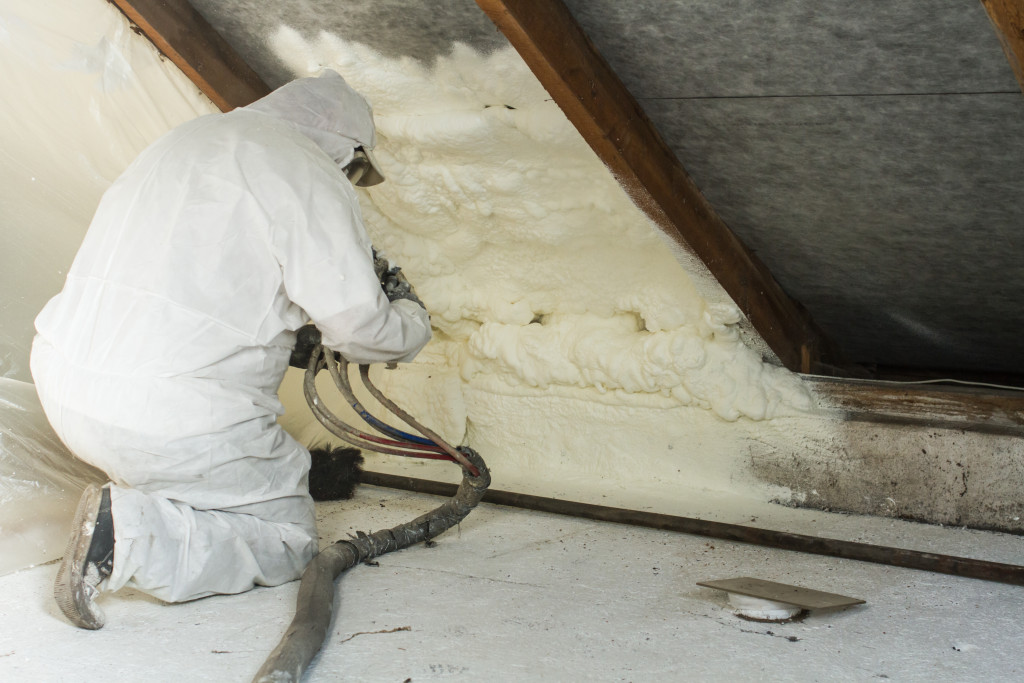- Spray foam insulation is an ideal option for businesses, helping to reduce energy costs and improve comfort.
- Installation involves spraying foam onto walls or ceilings to create a thermal barrier and airtight seal.
- Preparing for installation requires having the right equipment on hand, cleaning, and prepping the area.
- After installation, it is important to clean up any overspray and take preventative measures to avoid future problems.
- Regular inspection and maintenance are necessary to ensure the spray foam insulation performs effectively over time.
With spray foam insulation, you can ensure your business’s energy efficiency is operating at its peak performance. It’s a relatively simple process and can save you money in the long run. This guide will cover the basics of spray foam installation for businesses, including what it is, how it works, and what to expect during and after the installation process.
What Is Spray Foam?
Spray foam insulation is an expanding polyurethane foam sprayed directly onto surfaces to provide thermal insulation and air sealing. Spraying the foam onto existing walls or ceilings creates an effective barrier against heat loss and drafts. This makes it ideal if your business is looking to reduce its energy bills while also making its facility more comfortable.
How Does Spray Foam Work?
When the spray foam is applied, it expands and forms an airtight seal between walls and ceilings. By reducing air movement, spray foam insulation helps maintain a consistent temperature in your facility and also reduces drafts. It also acts as a sound barrier by reducing the noise from outside sources.
Benefits of Installing Spray Foam Insulation
Installing spray foam insulation offers several benefits to businesses:
Reduced Energy Costs
Installing spray foam insulation can significantly reduce your energy bills by trapping heat and preventing air leakage. In the long run, this can help you save money and make your facility more comfortable for employees and customers.
Improved Comfort
With adequate insulation, your business will be better able to maintain a consistent temperature throughout the facility. This reduces drafts and helps keep everyone in the building comfortable all year round.
Increased Durability
Spray foam insulation is incredibly durable and won’t deteriorate over time, like other types of insulation can. It also won’t settle or sag, making it an ideal choice if you want a reliable solution that lasts for years.
Preparing for Installation

Before you have spray foam insulation installed in your facility, there are a few things you’ll need to do:
Make Sure You Have the Right Equipment
Before installing spray foam insulation in your facility, you must ensure you have all the necessary equipment for the job. This includes safety goggles, respirators, and an adequate ventilation system that will help remove any fumes caused by the installation process.
Clean and Prep the Area
Before you start, it’s essential to thoroughly clean and prep the area that you’ll be spraying foam insulation onto. This includes removing debris or dirt from the surfaces and ensuring they are completely dry before applying the product.
Measure for Accuracy

Accurate measurements are essential for a successful spray foam insulation installation. Make sure to measure your walls and ceilings carefully and the area you will spray to ensure the best possible results.
Choose the Right Type of Foam
You’ll need to choose the right type of foam for your application based on the size and shape of the area you’ll spray. There are several types of spray foam insulation, so take time to choose the one that best suits your project.
Installation Process
The installation process for spray foam insulation is relatively straightforward. Here’s what to expect:
- The installer will use a hose to apply the foam directly onto the walls and ceilings.
- As it’s being sprayed, the foam will expand and fill in any gaps or crevices that may exist.
- Once the foam has cured (usually within 24 hours), it will form an airtight seal between walls and ceilings.
After Installation
Once your facility has been insulated with spray foam, there are a few things you’ll want to keep in mind:
Post-Installation Cleanup
After your spray foam insulation has been installed, cleaning up any overspray that may have occurred during the installation process is important. This includes wiping down surfaces with a damp cloth or using a vacuum cleaner to remove any excess foam from walls and ceilings. Additionally, you should use caution when sanding or cutting the foam to ensure you don’t damage the surface.
Spray Foam Overspray Prevention
It is important to take preventative measures when dealing with overspray from spray foam insulation. You can accomplish spray foam overspray prevention by utilizing aerial shields around the perimeter of the installation area. These shields will help to contain any overspray, preventing it from spreading and damaging nearby surfaces.
Inspection and Maintenance
Spray foam insulation requires regular inspection and maintenance to ensure it continues to perform effectively. Check the area periodically for signs of wear and tear, such as cracks or holes in the foam. If you notice any issues, have them inspected and repaired by an experienced professional right away.
In Summary
Spray foam insulation is an effective way to improve the energy efficiency of your business while also making it more comfortable for employees and customers alike. The installation process is relatively simple and can be done quickly with minimal disruption to your daily operations. Be sure to follow all safety guidelines when installing spray foam in your facility, and remember to maintain it regularly for optimal performance. With a bit of effort and preparation, you can significantly reduce energy costs while creating a better business environment.

